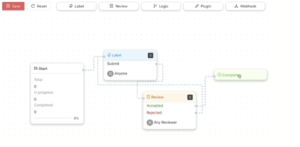Medical professionals face a growing workload, especially with the increasing tasks like patient documentation adding to their daily strain. 41% of healthcare providers report burnout due to long hours. This has created an urgent need for solutions to ease administrative burdens while supporting provider wellness.
Medical scribes powered by advanced technology are helping address this challenge. They listen to doctor-patient conversations and transform them into organized clinical notes. With healthcare moving quickly toward smarter solutions, many providers are already using this approach to save time and reduce stress.
A critical part of making this technology reliable is data annotation for AI. It helps ensure that ambient scribes accurately capture and organize information so providers can focus on delivering the best care.
In this article, we will discuss medical scribes and why data annotation for ambient scribes matters.
What is Ambient Scribe Technology?
Ambient scribe technology helps doctors and medical staff by turning real-time conversations with patients into clear clinical notes. It uses artificial intelligence (AI) and natural language processing (NLP) to capture real-time discussions between doctors and patients. It transcribes them accurately and then updates electronic health records with relevant information. This allows doctors to focus on their patients instead of paperwork.
For example, The Permanente Medical Group started using ambient AI technology to support over 10,000 physicians and staff. In just ten weeks, it helped with over 300,000 patient visits. Doctors shared that it made their patient interactions more personal and reduced the extra work they had to do after hours.
An AI-powered medical scribe is more than a simple transcription. It can generate detailed clinical documentation such as prescription orders, follow-up appointments, and summaries of patient findings. It also adapts to specialty-specific needs and can capture different voices, dialects, and accents. This makes it a valuable tool in multicultural healthcare environments.
How does it work?
Ambient scribe technology listens to conversations and turns them into detailed, accurate clinical notes (text).
Here’s how it works:
- Capturing the conversation: A smartphone or a specialized microphone is used to listen to the interaction. It can recognize and separate different voices, even in busy environments.
- Creating a dialogue flow: The AI processes the conversation in real-time, organizing the information into a clear dialogue flow. It captures important details like lab requests, imaging needs, medications, and follow-up plans.
- Categorizing the data: The AI uses data annotation to organize the transcribed information into relevant categories, making it easier to review.
- Summarizing the notes: The AI generates a final summary after the interaction. This summary is accurate, easy to read, and includes all critical details.
- Review and integration: The doctor reviews the notes, makes any necessary changes, and approves them. The notes are then conveniently added to the patient’s electronic health record (EHR).
Common Challenges Associated with AI Medical Scribes
AI medical scribes can improve clinical documentation but often face several challenges. These include:
1. Privacy and Security
AI medical scribes handle highly sensitive patient information, including medical histories, diagnoses, and treatment plans. This makes privacy and security one of the most critical challenges. These systems must implement strong safeguards to ensure compliance with strict healthcare regulations like HIPAA.
Key measures include end-to-end data encryption, role-based access controls, regular security audits, and activity logging. Failure to address these concerns could result in data breaches, eroding trust among healthcare providers and patients alike. In the first half of 2024, 387 healthcare data breaches involving 500 or more records were reported to the Office for Civil Rights (OCR).
2. Ambiguous Speech
Healthcare professionals often use complex medical abbreviations and acronyms, making it challenging for AI systems to interpret and transcribe conversations accurately. Moreover, varied speech patterns, regional accents, and different speaking speeds can add another layer of complexity.
AI systems risk producing incomplete or incorrect documentation without sufficient training on annotated datasets that include diverse speech patterns and specialized terminology. For example, confusion between terms like “hypo” (low) and “hyper” (high) in medical contexts can lead to significant errors in patient records. Additional complexities may also exist due to healthcare professionals often representing many ethnicities and dialects where the pronunciation of terms or phrases can vary substantially.
3. High Ambient Noise
Clinical settings, such as emergency rooms or busy hospitals, are inherently noisy. Background noise from medical devices, footsteps, overlapping conversations, and other ambient sounds can make it difficult for AI systems to isolate the primary speaker’s voice. This ambient noise can interfere with the AI’s ability to capture speech during consultations accurately.
High background noise levels can decrease transcription accuracy and impact the quality of clinical documentation. To overcome this challenge, advanced noise-canceling algorithms and properly annotated datasets for noisy environments are important.
4. Speaker Identification and Multiple Speakers
AI scribes often struggle to differentiate between speakers in clinical settings, especially when voices sound similar, or interruptions occur frequently. This can lead to errors in identifying who said what, affecting documentation accuracy.
For example, confusing a physician’s instructions with a patient’s response can create serious issues. To solve this, AI systems use speaker diarization, which separates and identifies speakers. However, this requires advanced machine learning models trained on real-world clinical conversations to improve accuracy.
5. Overlapping Conversations
Multiple people may often talk at the same time in busy clinical environments. For instance, the surgeon, anesthetist, and nurse might speak simultaneously during surgery. Basic transcription systems cannot handle overlapping speech well, leading to confusion in the documentation.
AI scribes need advanced speech separation technology to distinguish between voices and segment conversations accurately. They must also understand the flow of discussions to prioritize and document the most critical inputs in real-time.
Data annotation solves these issues by training the AI to recognize speech patterns better. It also helps the AI filter out noise and correctly identify speakers for more accurate results.
Data Annotation for Ambient Scribe
Data annotation labels data to help train AI and machine learning models effectively. For ambient scribes, this process ensures that the AI can accurately convert speech into text while capturing the context and nuances of clinical conversations. It learns to recognize complex patterns, understand medical terminology, and deliver precise transcriptions tailored to clinical workflows by providing the AI with well-annotated data.

Annotation also boosts the AI’s ability to grasp the context. This makes documentation more reliable and reduces errors. Annotation allows the AI to analyze nuanced interactions, such as recognizing tone, sentiment, or conversational patterns. The result is high-quality, accurate documentation that supports healthcare professionals without adding extra effort.
Key Annotation Types
Various types of data annotation help train ambient scribes for reliable and accurate clinical documentation. Here are the key annotation types:
- Speech-to-text annotation: Tags audio data with its corresponding text to train the AI for transcription. It helps the AI learn to convert spoken words into written text, even with varying accents or speech speeds.
- Part-of-speech tagging: Labels words in a sentence based on their part of speech in a context like a noun or verb. This helps the AI understand how sentences are built and improves its ability to process language correctly.
- Context annotation: Adds details like who is speaking, when they are speaking, and the purpose of their words. It helps the AI understand the flow of the conversation and organize the information better.
- Sentiment and emotion annotation: Labels the tone or mood of what is being said. It helps the AI recognize if someone is making a suggestion, expressing concern, or giving reassurance, which adds meaning to the documentation.
- Environmental context annotation: Tags background sounds or environmental signals. It helps the AI ignore noises like alarms or machine sounds and concentrate on the main conversation.
Why Data Annotation Matters for Ambient Scribe?
Data annotation can help address the common challenges ambient scribe systems face to ensure accurate and efficient medical documentation. For instance, annotated datasets train the system to differentiate between speakers. This enables it to clearly identify providers and patients, even in noisy clinical environments. Contextual annotations help the scribe system interpret the intent behind complex medical discussions to reduce ambiguity.
Data annotation helps the system recognize and document industry-specific terminology by labeling domain-specific terms and medical jargon. This ensures accurate transcription and reduces the risk of costly errors. Speech and acoustic annotations also enhance transcription accuracy, adapting to varied accents and speech patterns. This allows providers to focus on patient care rather than documentation tasks to improve both healthcare delivery and patient outcomes.
Data Annotation Best Practices for Ambient Scribe
Following best practices in data annotation is crucial to build an effective ambient scribe system. Here are some simple yet effective ways to ensure high-quality annotations:
- Set clear labeling guidelines: Provide annotators with clear instructions to maintain consistency. This ensures everyone understands how to label the data accurately.
- Offer domain-specific training: Equip annotators with the knowledge they need to handle complex medical terminologies and scenarios. Specialized training improves accuracy and relevance.
- Implement quality checks: Review annotations regularly to spot errors and ensure consistency across annotators. Use inter-annotator agreement metrics to maintain high standards.
- Avoid data bias: Assemble a diverse team of annotators to reduce bias and ensure the system works well for different accents, speech patterns, and demographics.
- Prioritize data privacy and security: Handle sensitive audio datasets with care. Use secure systems and anonymize data to protect patient information.
- Leverage annotation tools: Use advanced tools like iMerit’s Ango Hub to simplify and speed up the annotation process. These tools can improve precision and reduce manual errors.
Automate Clinical Documentation with iMerit’s Advanced Ambient Digital Scribing
iMerit addresses these challenges with its advanced ambient digital scribing services, designed to streamline documentation and improve accuracy. iMerit achieves this by integrating domain knowledge with state-of-the-art AI solutions and empowers medical professionals to concentrate on what matters most: giving excellent patient care.

Learn how iMerit helped a tech titan improve its LLM’s ability to summarize patient/doctor conversations and generate summaries for EHRs.
What iMerit offers:
- Automates clinical documentation to reduce the workload for healthcare providers.
- Validates and summarizes key clinical information such as diagnoses and medical history.
- Fine-tune generative AI models to meet medical standards and ensure regulatory compliance.
- Provides response ranking and evaluation to improve AI model performance.
- Enhances the accuracy of transcriptions through supervised fine-tuning.
- Ensures privacy and security of sensitive medical data in compliance with ethical standards.
- Ensures compliance with HIPAA and other regulatory standards to protect sensitive patient information while maintaining high-quality documentation.
Moreover, iMerit offers Ango Hub which is an AI data workflow automation platform that accelerates AI into production. It is built on quality-first principles to ensure every annotation is precise:
- Collaborative workflows: Multiple annotators review the same asset to capture consensus and address edge cases.
- Guided annotation: Highlighting exemplary samples directs the team for consistent quality.
- Rigorous quality control: Reviewers can accept, modify, or reject annotations as needed.
- Real-time feedback: Instant troubleshooting catches and corrects errors immediately.
- Benchmarking & guidelines: Custom benchmarks and detailed guidelines keep performance uniform.
Ready to transform your clinical documentation process? Contact iMerit today to learn how our advanced solutions can help your healthcare organization achieve efficiency and accuracy.


























